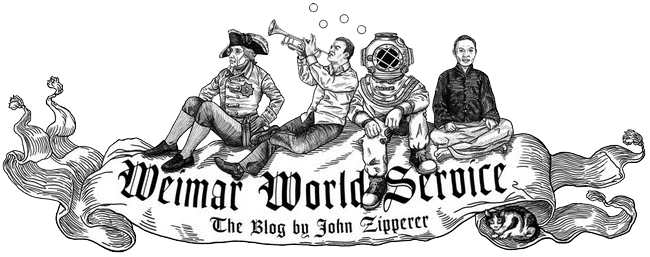
That's what we found out in the late 1980s. I was the editorial pages editor of The Badger Herald, the independent daily student newspaper at the University of Wisconsin-Madison, and we had to come up with an idea for our April 1 issue, the annual April Fool's edition. We hit upon the idea of doing a parody of USA Today, mimicking its design, colors, and -- most important -- its editorial tone of "we're all happier today."
The parody we produced was, if I many say so myself, quite good. We got lots of great feedback from readers, including someone at USA Today who wrote to let us know they loved the parody so much they'd like us to send them some extra copies, which we did. Feeling on a roll, the next April 1 issue was planned as a follow-up USA Today parody; in preparation, one of our editors contacted that paper to ask for the exact colors of the logo and the name of the typeface, so we could better mimic it on our end. The word came back from the East Coast that parodies are all fine and good, but if we did it again they'd sue us.
So, no follow up.
But I've always been a fan of good parodies. Magazines and newspapers are perfect targets for parodies, because readers have spent a lot of time with them, and the editors and publishers have spent years designing the magazine so that it's memorable in tone, design, and quality. It lets a (hopefully talented) humorist play in a world made by someone else, tweaking them, bringing them down to earth, and playing with their ego.
There are a couple masters of the magazine parody: Harvard Lampoon and National Lampoon. Both have published books with compilations of their magazine parodies: 100 Years of Harvard Lampoon Parodies (Harvard Lampoon, 1976) and National Lampoon Magazine Rack (National Lampoon Press, 2006). The older of the two, Harvard Lampoon, is the granddaddy of the genre, and it keeps active with last year's National Geographic parody (pictured). The USA Today parody picture on this page, by the way, is from the Harvard Lampoon, not the Badger Herald. I don't know where our Herald copies are.

But parodies have been done by many, many others. Playboy once published a parody of competitor Men's Health. Mad and Cracked did many parodies over the years. Mole magazine, a short-lived humor magazine in the early 1980s, included a New Republic parody in its first issue (not exactly reaching for a wide audience with that one, I'm afraid).
Playboy itself has, naturally, been the target of many lampooners over the decades, going all the way back to the 1950s. Harvard Lampoon produced one of its most popular parodies with its 1966 parody, PL*YB*Y (which featured, among many other treasures, an interview with the Magic Eight Ball). You've got to love a magazine that lists in its next-issue section a featured interview with Christopher Robin. Very early in its run in the 1970s, National Lampoon published its Playdead parody. But it was the 1980s when the leading men's magazine faced an onslaught of parodies, including Playboy The Parody (which featured "The Girls of Penthouse" -- cute joke, that) and Playbore (whose editors seemed to rather dislike Hugh Hefner quite a bit, judging from his portrayal in the magazine).

Harvard Lampoon's still at it, of course, even well into its second decade of ruling-class humor. Last year it published its National Geographic parody (which I neglected to pick up, and have been kicking myself since), and its five-times-a-year magazine continues to be published out of the Lampoon castle near Harvard U.
And parodies are international. In the mid-1980s, there was a German-language parody of Playboy published, Playbock, which included translations of articles and photos from the English-language Playboy The Parody and Playbore, as well as original material specific to readers of the long-running German edition of Playboy. The same German parodists produced take-downs of venerable German news magazine Der Spiegel and Stern (pictured). If you don't read German, it might just be wasted paper to you, but for those who do know the language, it's proof that Germans do, after all, have a sense of humor.

What all this (and more; there've been parodies of Sports Illustrated, Time, The Economist, Fangoria, Newsweek, and tons of others) means is that a lot of other snarky writers and editors didn't let a little thing like the threat of legal action deter them from having fun in someone else's playground.
Does anyone know where I can get a copy of the Badger Herald USA Today parody?
7/27/09 UPDATE: Yes, someone does.

No comments:
Post a Comment